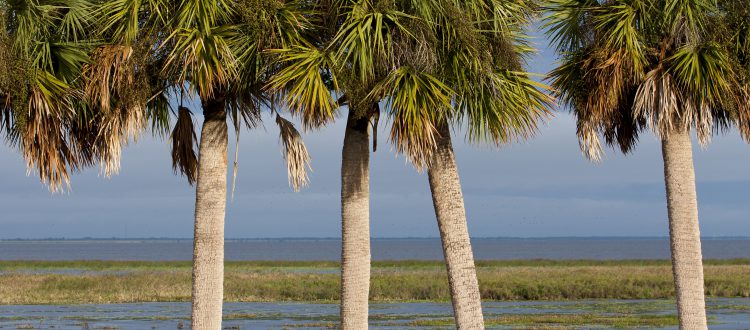
Cabbage palms and birds on Lake Okeechobee. UF/IFAS Photo by Tyler Jones.
Sponsor
South Florida Water Management District (SFWMD)
Award Dates
February – December 2019
Participants
Project Lead: Wendy Graham
Project Participants: Mark Brenner, Lisette Staal (University of Florida), Jim Fourqurean, Jayantha Obeysekera, (Florida International University),
Goals and Objectives
The south Florida regional landscape has been engineered to provide flood protection and water supply. Lake Okeechobee is the main location for surface water storage in this system. As part of the Central and Southern Florida (C&SF) Project authorized in 1948 the system was engineered with two large canals that now have the capacity to carry large volumes of water from Lake Okeechobee to the St. Lucie and the Caloosahatchee estuaries. Considerable impacts to the natural ecosystems of south Florida, including the St. Lucie Estuary, Caloosahatchee Estuary, Lake Okeechobee, and the Florida Everglades stem from large deviations in the quantity and quality of freshwater delivered to these systems relative to a pre-engineered time period. Lake Okeechobee is regulated and managed by the U.S. Army Corps of Engineers (USACE) in collaboration with SFWMD who provides information. Currently, they are planning a lake regulation review that will consider alternative regulation schedules that take into consideration the tradeoffs between health of the lake, estuaries, Everglades, as well as provision of flood control and water supply.
This project aims to to conduct an independent scientific review to help inform the development of the next Lake Okeechobee Regulation Schedule. To do so, the Water Institute convened an interdisciplinary academic review team that will:
- Acquire and synthesize existing scientific information related to the impacts of the Lake Okeechobee regulation schedule on the ecology of Lake Okeechobee and the estuaries that receive lake discharges;
- Identify knowledge gaps and additional data needed to assess the ecological impacts and tradeoffs of proposed changes to LORS; and
- Develop recommendations and priorities for new efforts needed to fill gaps in existing knowledge
Available Outputs
Title: Scientific Synthesis to Inform Development of the New Lake Okeechobee System Operating Manual
Authors: Graham, W. D., M. Brenner, J. Fourqurean, C. Jacoby, and J. Obeysekera

